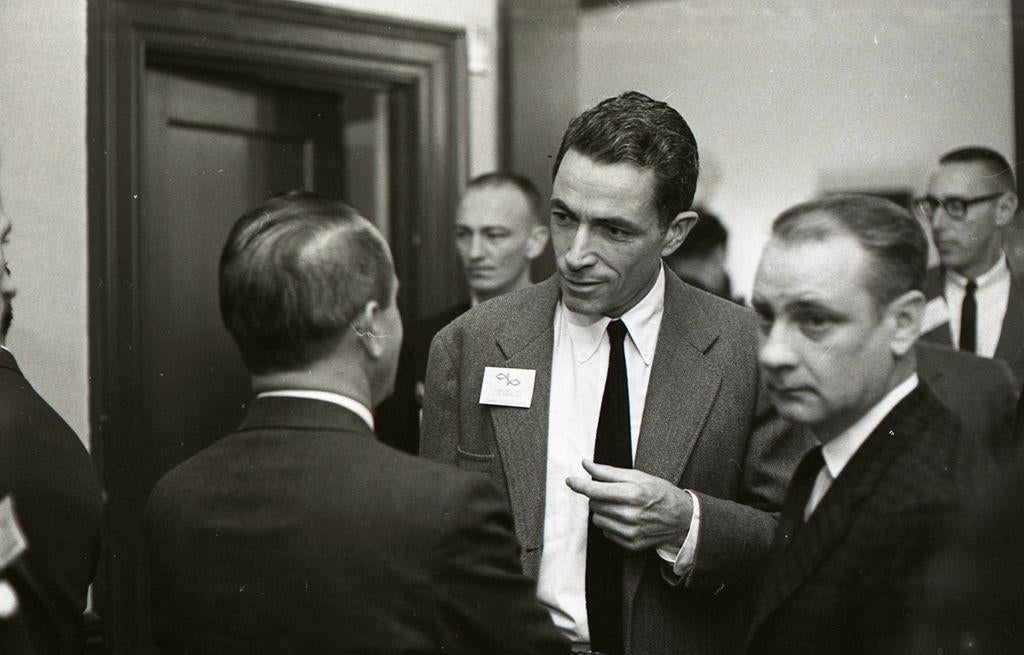July and August have been a treasure trove of discoveries on JSTOR, offering an array of collections and multimedia that span the historical spectrum—from the activism of the Civil Rights era to the artistic resilience during the AIDS epidemic.
This month, we delve into these materials, each providing unique insights into the past and reminding us of the power of history, culture, and knowledge.
Senator Claiborne Pell: A legacy of libraries and literacy

In 1968, Senator Claiborne Pell passionately advocated for libraries and literacy programs, emphasizing their critical role in empowering individuals and communities. His address, now preserved on JSTOR, resonates as strongly today as it did over five decades ago.
Pell’s vision was clear: libraries are not merely repositories of books, but dynamic hubs that nurture curiosity and provide answers to the millions of questions we hold. As we reflect on his words, it’s evident that these institutions continue to be the backbone of an informed and literate society.
Watch the full video and explore the collection “The Senatorial Papers of Claiborne Pell, 1960-1997, Audiovisual Collection” from the University of Rhode Island.
Johnny Mize: The Big Cat’s home run legacy

Johnny Mize, fondly known as “The Big Cat,” left an indelible mark on baseball history. From his debut in 1936 to his retirement in 1953, Mize’s prowess on the field was undeniable—359 home runs, a .312 batting average, and five World Series titles.
The Johnny Mize Collection on JSTOR from Piedmont University offers a deep dive into his life, not just as a baseball legend, but as a symbol of determination and excellence. This collection serves as a celebration of a sportsman who inspired generations of players and fans alike.
Visit the Johnny Mize Collection to experience the legacy of one of baseball’s greatest.
Back to school: A glimpse into 1967 campus life

As students return to school, what better way to get into the spirit than by revisiting the University of Puget Sound’s 1967 campus life? This nostalgic film, now available on JSTOR, takes viewers back to a time when aerial views of the campus and candid moments of student life captured the essence of college spirit.
Whether you’re a current student or an alum, this film is a beautiful reminder of the timelessness of school traditions and the vibrancy of campus communities.
Watch the full video and take a trip down memory lane.
Renaissance wisdom: The 15th-century folding almanac

Step into the world of medieval medicine and astrology with a Latin folding almanac from the early 15th century. Available courtesy of the Wellcome Collection, this almanac is a remarkable artifact that blends astrology with practical medical advice.
The intricate “Zodiac Man” illustration, along with astrological tables and religious calendars, offers a glimpse into how people of the time sought to understand their world and their health. This almanac reflects the mindset and practices of an era that laid the groundwork for modern science and medicine.
Explore this historical treasure and dig into medieval medical practices.
Visual arts and the AIDS epidemic: Stories of resilience

The “Visual Arts and the AIDS Epidemic: An Oral History Project” collection from the Smithsonian’s Archives of American Art is a poignant exploration of how the art community responded to one of the most devastating health crises of the 20th century.
Through oral histories, this collection on JSTOR captures the voices of artists, writers, curators, and activists who used their creativity and resilience to confront the impact of HIV/AIDS. Their stories are about the power of art to heal, protest, and memorialize, and this collection is a testament to the enduring strength of the human spirit in the face of unimaginable adversity.
Discover the narratives that intertwine art, activism, and personal loss in this moving collection.
Montana’s opera history: A cultural journey

Opera enthusiasts will find a rich cultural journey within the John Frederick Santilli and Suzanne Day Collection from Montana State University. This collection, now freely accessible on JSTOR, showcases programs from Montana’s opera productions dating back to 1979.
These documents not only highlight performances but also reflect the growth and evolution of opera as a cultural institution in Montana. Whether you’re a dedicated opera fan or a casual observer of the arts, this collection offers an insightful look into a cherished tradition.
Explore the collection and immerse yourself in Montana’s operatic history.
Civil Rights Digest in Reveal Digital: A window into the Southern struggle

The Civil Rights Digest collection (1968-1974) is part of Reveal Digital’s Behind the Scenes of the Civil Rights Movements initiative, which sheds light on pivotal moments and underrepresented voices from the American South during the civil rights era. This collection, curated from the archives of the Atlanta History Center, includes powerful writings, correspondence, and research papers of key figures such as Dr. Clarence Bacote. Through these materials, researchers and students can explore the social and political dynamics that shaped a transformative period in American history.
Dive into the collection here and explore how the fight for equality and justice was documented in real time by those on the front lines.
Trinity College: Tradition and scholarship

Trinity College’s video “‘Neath the Elms,” narrated by Associate Professor John Dando, is an invitation to explore the rich traditions and academic excellence that define this historic institution.
The video, now on JSTOR, captures the essence of campus life, from the excitement of football games to the serene beauty of the Watkinson Library, home to treasures like Audubon’s Birds of America. Whether you’re a part of the Trinity community or simply an admirer of history and education, this video offers a heartwarming portrayal of college life in the 1950s.
Watch the full video and discover the traditions that have shaped generations at Trinity College.
The evolution of livestock farming: A scientific perspective

Journey through the evolution of livestock farming with an instructional film from 1953, now open access on JSTOR. This film, part of the Wellcome Collection, contrasts the natural pastures of buffalo with the scientific advancements that transformed modern farming.
From the introduction of enriched feed to the use of antibiotics like Aureomycin, this film highlights the intersection of tradition and innovation in agriculture. It’s a fascinating look at how science has revolutionized the way we approach livestock farming, making it a must-watch for anyone interested in agriculture and science.
Explore the film and see how farming has evolved over the decades.
Student activism at West Virginia University

We’re excited to highlight the Scott Bills, Student, Activist Records from West Virginia University, now available as part of Reveal Digital’s Student Activism collection. This collection offers a detailed look into the vibrant history of student activism at West Virginia University, capturing key moments in the fight for social justice. It includes newspaper clippings, fliers, petitions, and other documents that reflect the energy and dedication of students involved in movements such as the Anti-Vietnam protests and the United Farm Workers boycott.
Sourced from West Virginia University Libraries, these records bring to life the voices and actions that shaped the university’s policies and influenced broader societal changes. The collection provides a compelling window into how student activism can create lasting change.
Whether you’re a researcher, a student, or simply someone with a passion for the past, there’s something here for everyone to explore and enjoy.



